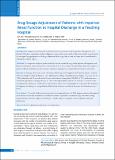Please use this identifier to cite or link to this item:
https://hdl.handle.net/20.500.14356/1792Full metadata record
| DC Field | Value | Language |
|---|---|---|
| dc.contributor.author | Sah, S K | - |
| dc.contributor.author | Wanakamanee, U | - |
| dc.contributor.author | Lerkiatbundit, S | - |
| dc.contributor.author | Regmi, B M | - |
| dc.date.accessioned | 2023-05-23T05:24:57Z | - |
| dc.date.available | 2023-05-23T05:24:57Z | - |
| dc.date.issued | 2014 | - |
| dc.identifier.citation | SahS. K., WanakamaneeU., LerkiatbunditS., & RegmiB. M. (2014). Drug Dosage Adjustment of Patients with Impaired Renal Function at Hospital Discharge in a Teaching Hospital. Journal of Nepal Health Research Council. https://doi.org/10.33314/jnhrc.v0i0.439 | en_US |
| dc.identifier.issn | Print ISSN: 1727-5482; Online ISSN: 1999-6217 | - |
| dc.identifier.uri | http://103.69.126.140:8080/handle/20.500.14356/1792 | - |
| dc.description | Original Article | en_US |
| dc.description.abstract | Abstract Background: Inappropriate dosing and the risk of toxicities are common with the patients with impaired renal function. Therefore, appropriate dosing is obligatory to prevent the drug toxicities. The present study was performed to investigate the appropriateness of dosage adjustment of the drugs that are toxic to kidney and/or metabolized or eliminated (TEM) by kidney. Methods: A retrospective studywas performed at the time of hospital discharge in the patients with impaired renal function. All patients with renal clearance ≤50 ml/min/1.73 m2 were included for the analysis. Data with respect to patient’s clinical, medications and their dosages, laboratory findings were extracted from medical record section.  Results: At discharge, there were a total of 848 prescribed drugs in 116 impaired renal function patients. Of them 404 were classified as TEM medication. Dose adjustment according to renal function was judged as necessary in 135 TEM medications and 28 were deemed to be used with caution. Among these, 108 (80% of 135) medications were considered appropriate in dosing, whereas 27 (20%) were inappropriate. Total 14 (10.37%) and 13 (9.63%) times of inappropriate dosing were found in those with moderate and severe renal impairment, respectively. The frequency of inappropriate dosing was not significantly different from moderate than that of the severe renal impairment (p >0.05).  Conclusions: The results of the study demonstrated that dosage adjustment of TEM drugs in patients with impaired renal function is less than optimum in a considerable number of patients at hospital discharge. Awareness raising and monitoring system for inappropriate dosing is critical to improve the quality of care in patients with renal dysfunction.  Keywords: dose adjustment; renal drugs; renal impairment. | en_US |
| dc.language.iso | en | en_US |
| dc.publisher | Nepal Health Research Council | en_US |
| dc.relation.ispartofseries | Jan-April, 2014;439 | - |
| dc.subject | Dose adjustment | en_US |
| dc.subject | Renal drugs | en_US |
| dc.subject | Renal impairment | en_US |
| dc.title | Drug Dosage Adjustment of Patients with Impaired Renal Function at Hospital Discharge in a Teaching Hospital | en_US |
| dc.type | Journal Article | en_US |
| local.journal.category | Original Article | - |
| Appears in Collections: | Vol. 12 No. 1 Issue 26 Jan - Apr, 2014 | |
Files in This Item:
| File | Description | Size | Format | |
|---|---|---|---|---|
| 439-Article Text-584-1-10-20140709.pdf | Fulltext Download | 241.65 kB | Adobe PDF |  View/Open |
Items in DSpace are protected by copyright, with all rights reserved, unless otherwise indicated.
